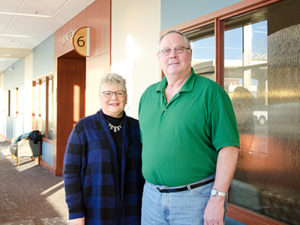JAMESTOWN, N.D. (JRMC) – Twenty days after total hip replacement surgery, Mark Lee was out doing woodwork, shoveling and blowing snow at home, doing work at his church and going to the gym. Mark was strong and felt great. But infection was lurking.
Mark’s surgery was in November. That January, while sitting in church he noticed his pocket hankie was wet.
After a trip to the restroom, he realized there was a problem. He was leaking from his incision.
With any joint replacement, there are risks including bleeding, blood clots and infection. Mark admits he did too much after surgery and felt that triggered his surgical site infection.
“Not thinking that the inside had to heal, I just didn’t take that into consideration,” says Mark about his post-operative activities.
The Center for Disease Control (CDC) reports that in the United States, one in every 25 patients will contract a hospital-acquired infection (HAI) and of those, one in nine will die. HAIs are devastating for patients and also costly for everyone involved. Hospitals typically spend anywhere from $15,000 to $50,000 treating patients who are readmitted with infection. This can be pneumonia, gastrointestinal illness, Clostridium difficile (known as “C. diff”), urinary tract infections, primary bloodstream infections and surgical site infections for any inpatient surgery.
Mark had surgery in February to clean the joint and replace it with an implanted joint. Again infection set in and in March, Mark returned to the operating room for the third time. This time, doctors removed the implanted joint and placed an antibiotic spacer. This treatment delivers antibiotics directly to the infected tissues and helps the re-implantation procedure. In June, Mark had his forth and final surgery. Today, he’s recovering well.
As part of each surgery medical professionals infused a course of antibiotics which lasted six to eight weeks. Mark also required home care and rehabilitation. “The home health nurses were excellent,” Mark shares.
“Dr. Timothy Volk was super. He warned me that if we can’t cure the infection, I’d have to go to travel to Minneapolis for follow-up care. I didn’t want that. Fortunately, the team was able to cure it,” Mark says.
Dr. Volk is one of two orthopedic surgeons at Jamestown Regional Medical Center.
“It was one heck of an experience,” Mark says, but he couldn’t have been happier to have it done at JRMC. “It would have been so much more,” notes Mark about the burden of travel time and cost.
Mark and his wife Dixie were both happy about the course of treatment but had wisdom for JRMC and other orthopedic patients. “Don’t overdo it and tell patients that this is an internal healing process.”
“Even if you feel great, it takes time to recover,” Mark says.
“They all hung in there for us and took care of me like family. We were on a first name basis,” Mark says. “I’m doing my normal daily activities. So I have to thank the professionals at JRMC for what they’ve done for me.”
PREVENTING INFECTION
Germs. They are a stubborn and difficult problem that cause HAIs. JRMC is continually seeking better ways to banish these germs and bacteria.
“Surgical site infections are rare at JRMC,” says Jenna Bredahl, quality manager. “Eight were reported at JRMC in 2017, far below the national average of 1,571.”
Currently, JRMC adheres to CDC infection control guides and works hard to prevent infections. This includes disinfection and sterilization, isolation precautions, environmental infection control and good hand hygiene.
But, some germs are nearly impossible to clean by hand. Cue the Xenex LightStrike Robot.
GERM-ZAPPING ROBOT
JRMC is purchasing its first-ever Xenex Lightstrike “germ-zapping” robot. The robot is a wheeled machine that emits pulsating ultraviolet light that’s proven to zap infection-causing bacteria.
Resembling a bug zapper or camping lantern, the robot’s pop-up UV cylinder emits blinding-white, xenon-fueled light that bounces into walls, floors, ceilings and hard-to-clean crevices… places manual cleaning might miss.
“The robot gives us one more tool in the arsenal,” says Dane Grebel, manager of environmental services for JRMC. “JRMC is a state-of-of-the-art facility and demands the highest level of care. This robot gives everyone more confidence from a patient-safety perspective.” The robot does replace manual disinfecting and cleaning by employees.
The robot will work in areas where patients are most at risk for infections: operating rooms, emergency department and patient care rooms. The high-intensity UV light passes through the cell walls of bacteria, viruses and bacterial spores to break down and destroy them.
Other facilities using the robot have reported ZERO infections since the implementation of the robot over a one-year period.
“JRMC is a leader in medical technology. It’s only fitting that we should employ innovative technological solutions to care for our facility. One hospital-acquired infection is one too many, so we are excited to use the Xenex system to ensure we deliver the finest quality of care,” says K.C. DeBoer, JRMC CEO.
To learn more about the Xenex germ-zapping robot, visit www.jrmcnd.com/giving.

